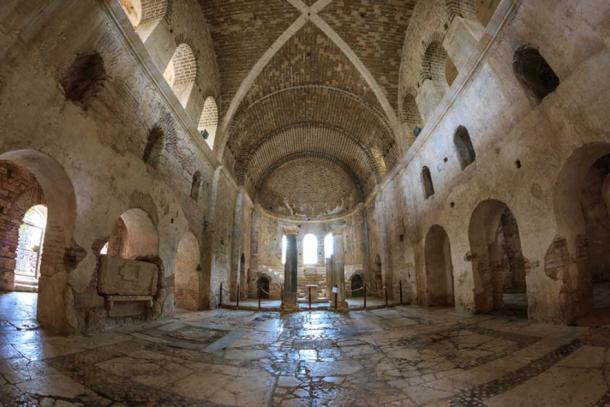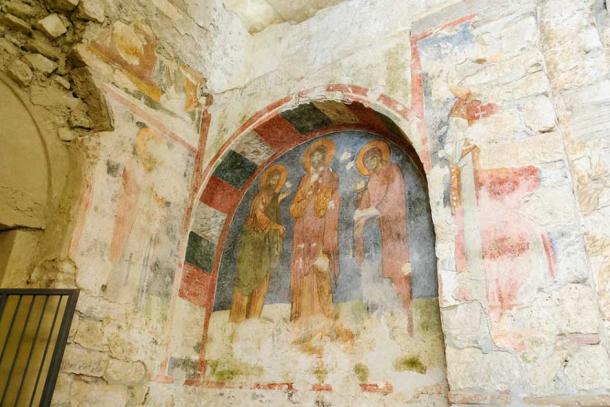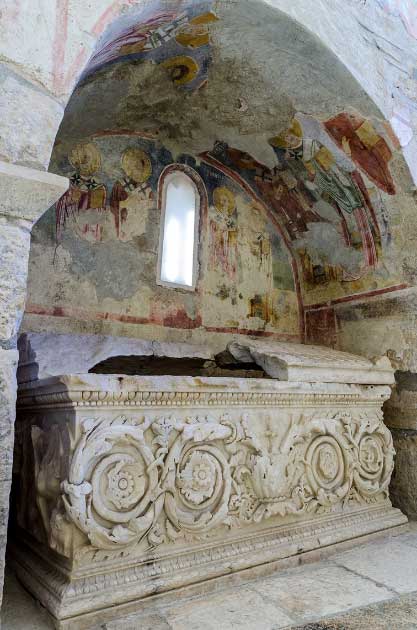Santa Claus is a mythological character, loved by children and adults alike around the world. But the fictional Jolly Old Saint Nick was actually inspired by a real-life St. Nicholas, who resided not on the frigid ice sheets of the North Pole, but in the far-off lands of southern Turkey. This St. Nicholas died in the fourth century AD, and when he passed away he was buried inside the church where he served, in the Demre district of the modern-day Turkish province of Antalya.
Following the vandalism of his grave in the 11th century, during which his skeletal remains were stolen, the exact spot where St. Nicholas was buried was forgotten. But now, after centuries of speculation and decades of searching, a team of Turkish archaeologists believe they have finally uncovered the precise location of St. Nicholas’s tomb underneath the floor of an ancient church known as, appropriately enough, the Church of St. Nicholas of Myra.

Interior of the Church of St. Nicholas of Myra in Demre, Turkey. ( erikzunec / Adobe Stock)
Searching for the Tomb of Saint Nick
Osman Eravşar, the chairman of the Antalya Cultural Heritage Preservation Regional Board, has just announced that St. Nicholas was entombed in 343 AD inside a sarcophagus underneath a church fresco that depicts Jesus Christ.
While the current Church of St. Nicholas was only constructed in 520 AD, it was built directly over the older church that was chosen as the burial site for the celebrated religious icon. And thus, below two floors placed on top of one another, the body of the famous St. Nicholas would have been interred.
“His sarcophagus must have been placed in a special place, and that is the part with three apses covered with a dome,” Eravsar told the Turkish news service DHA. “There we have discovered the fresco depicting the scene where Jesus is holding a Bible in his left hand and making the sign of blessing with his right hand.”
Archaeologists uncovered the original floor and foundation of the old church during recent excavations. They had to dig through several feet of sand and silt to get there, as the old church was actually destroyed by a medieval flood, necessitating the need to construct a new one on the same site. “We are talking about the floor on which St. Nicholas’s feet stepped,” Eravşar enthused. “This is an extremely important discovery, the first find from that period.”

For archaeologists working to find the tomb of St. Nicholas, a fresco of Jesus within the Church of St. Nicholas in Demre, Turkey, provided clues to the exact location of his burial. ( Vladimir Muravin / Adobe Stock)
Finding the Exact Location of St. Nicholas’s Tomb
The older pre-sixth century floor was made from mosaic marble tiles, one of which was inscribed with Greek words that translate into “as grace” in English. Eravsar is certain this was placed to mark the exact location of the tomb of St. Nicholas, in the church where he worshipped when he was alive.
Notably, the church building bears a striking architectural similarity to the Church of the Holy Sepulchre in Jerusalem. In both buildings the dome on top has been left open and unfinished. This may have been done to associate St. Nicholas directly with the story of Jesus’s crucifixion and ascension to heaven.
In electronic scans taken in 2017 , another team of archaeologists found empty spaces between the old church floor and its foundation. It was known that one of these empty spaces had at one time held St. Nicholas and his sarcophagus.
The Antalya Cultural Heritage Preservation Regional Board’s announcement that they had found the actual location of the tomb represents the culmination of five years of archaeological work, if indeed their deductions about what the fresco, inscribed tile and open dome really represent are correct.

Over the centuries, several different tombs have been identified as the location of the burial of St. Nicholas, including this sarcophagus within Church of St. Nicholas of Myra in Turkey. ( Arseniy / Adobe Stock)
Meet the Original Santa Claus
The inspiration for the character of Santa Claus was born in the year 270 to a Greek family living in Asia Minor, in the Mediterranean port city of Patara located within the southwestern part of modern-day Turkey. At this time the region was under the control of the Roman Empire , and Nicholas and his family lived under Roman authority as devoted Christians.
Nicholas came from a wealthy and influential family. But rather than spending his inherited fortune on himself, Nicholas gave it all away, as he dedicated himself to serving the sick and the poor. His most well-known charitable practice was secretly giving gifts to poor children from destitute families. He became so well-known for this that children in the region eventually begin hanging stockings or shoes out hoping that Nicholas would come and fill their stockings with presents (which he often did).
The most famous story of St. Nicholas and his good deeds tells of how he once gave three impoverished young girls dowries, to prevent them from being forced into prostitution. He left bags of gold at their homes anonymously, but because of his reputation for goodness everyone knew who had saved the girls from their terrible fate.
While still a young man, Nicholas was made the Bishop of the city of Myra. In this role his generosity garnered more strength and admiration, and after he died on December 6, 343, it soon became the custom to give children gifts on the eve of the anniversary of his death.
The day of gift giving was moved to later in December following the Reformation, creating an association with the reputed birthday of Christ . But St. Nicholas’s connection to the practice was preserved through the character of Santa Claus , or St. Nick, who became the mythological embodiment of a larger-than-life, unfailingly generous character.
Tomb of ‘Santa Claus’ is FOUND: Burial spot of Saint Nicholas discovered https://t.co/ylpIeIMIzH
— Daily Mail Online (@MailOnline) October 19, 2022
Archaeology by Deduction
In most instances, archaeologists identify the locations of tombs by unearthing skeletal remains and burial goods. Unfortunately, that was not possible with St. Nicholas, and archaeologists needed to use their skills in deduction.
In the year 1087, a group of powerful merchants from the Italian city of Bari came up with a plan to steal St. Nicholas’s remains from their proper resting place in the Turkish church that carried his name. According to a historical manuscript translated by a medieval scholar named Charles W. Jones, the conspirators planned to “break open the floor of the church and carry away the holy corpse.”
The plan was a success and the thieves stole St. Nicholas’s bones and destroyed his sarcophagus. His remains are believed to have ended up in Bari, although what happened to them after that is still a mystery.
Needless to say, this complicated the search for St. Nicholas’s final resting place. Instead of there being a body and coffin to find, archaeologists have been required to deduce how the symbolism and architecture of the church might relate to St. Nicholas and his legendary burial.
The announcement that the site of St. Nicholas’s tomb has finally been located may not gain universal acceptance, since there is no actual body to prove the assertion true. But this conclusion does seem to rest on a solid foundation of reasonable interpretation, and that may be enough to convince most experts that the search for the real St. Nick’s tomb has finally come to an end.
Top image: The statue of St. Nicholas in Demre, Turkey. Source: olinchuk / Adobe Stock
By Nathan Falde
Related posts:
Views: 0
 RSS Feed
RSS Feed















 October 23rd, 2022
October 23rd, 2022  Awake Goy
Awake Goy  Posted in
Posted in  Tags:
Tags: 
















